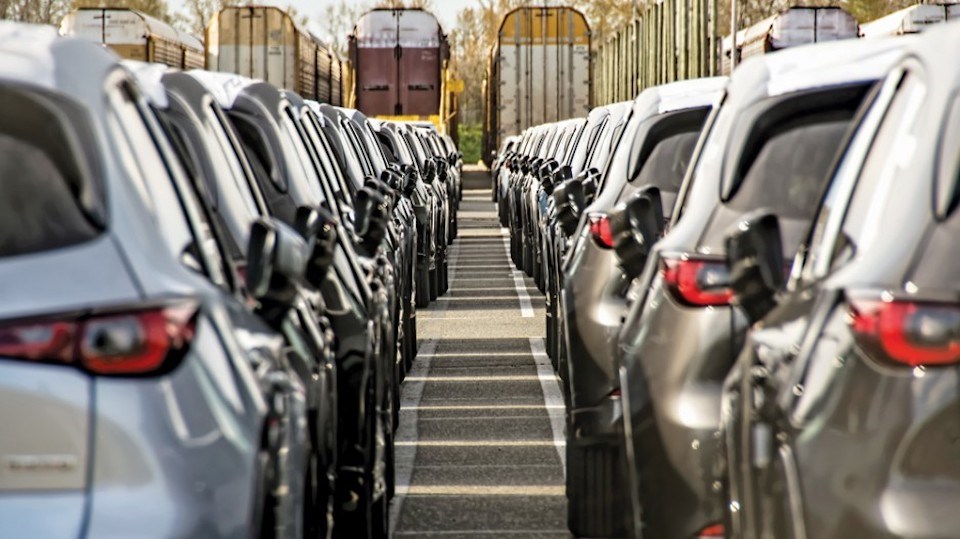Driving along Highway 1 past the North Surrey Auto Mall on a typical pre-COVID day, motorists could expect to see a collection of new cars on display – often through the glass walls of the elevated showroom of one dealership, at drivers’ eye level, right next to the road.
Today, there are no cars – only printed images of cars affixed to those same glass walls.
This situation is now the norm in the automotive industry in B.C. and everywhere else. Supply chain snarls stemming from the COVID-19 pandemic, as well as increasing global unrest in several key markets, have eradicated dealers’ inventories of new vehicles.
Industry officials estimate that North American dealers now have new vehicle inventories of fewer than seven days (the amount of time it would take a dealer to sell out of its vehicles if no new cars arrive). The industry norm is 45 to 70 days.
“Different groups measure in different ways in terms of what’s the lag time versus what the inventory time is,” said Huw Williams, director of public affairs at the Canadian Automobile Dealers Association. “But I can tell you for the moment the inventory is very, very short.… We originally anticipated the situation would return to normal this summer. Now, I think that’s going to be delayed a few more months.”
Blair Qualey, president and CEO of the New Car Dealers Association of BC, said that while he cannot confirm the exact inventory situation of each dealership, the number of new cars to sell is at a record low.
“Anyone who drives by a dealership can see the situation,” he said. “I talk to the dealers, and anecdotally from them, it’s a huge challenge for many brands … The number of new vehicles that are available is few and far between, and I suspect it will continue for several months to come.”
The primary culprit is a shortage of the kinds of computer chips that are now pervasive in modern automobiles in every facet of operation. But Qualey added that it isn’t just the chips that are now in short supply.
“These are highly sophisticated, highly technical vehicles that we run around in every day,” he said. “We take it all for granted – perhaps until you open the hood see all the complexities under there.… COVID has closed various manufacturing plants for everything from wiring harnesses to seats.”
Another major snag – though its effect is not yet widely apparent – is the lockdown of Shanghai and the paralysis of its port, where many automakers produce, ship and receive their parts for final assembly of vehicles elsewhere.
“Lately, there are people referring to the lockdown of Shanghai – a whole city of 25 million people – where a lot of manufacturing and other things that are done there for both the Chinese vehicle market and markets in other places,” Qualey said. “We don’t think of the global supply chain of these myriads of pieces that go into making a single vehicle.”
Among the items consumers will have to get used to:
•More limited choices at dealerships lots – maybe permanently. Toyota Motor North America executive vice-president Bob Carter said this month that the automaker may look at returning to a 30-day inventory as a goal for dealers – down from the pre-COVID goal of 45 days. “We may be looking at a new normal where dealers will run with lighter inventories, and consumers will have to adjust to that,” Williams said.
•Cars may be sold with parts to be added later. Qualey said some dealers are taking deliveries from automakers with a rain check: A list of all the missing microchips that will be installed in the car once the chips become available. “So the vehicle doesn’t have its heated seats or its heated steering wheel … that one might normally expect,” he said. “At least [buyers] will have a reliable vehicle they can drive safely, but they may not have all the bells and whistles right away.”
•Consumers may not be able to test drive a vehicle. “Usually, under normal circumstances, you could go to the dealers and say, ‘I want to test drive that one,’ and you can try it and go from there,” Qualey said. “Unfortunately, today, if you’re looking for some new models, you are going to have to wait some months.… Everyone’s patience is being tested, and it’s a whole new sort of marketplace.”
•More used-cars sales. The lack of new cars has driven prices of used cars to record highs, which has helped dealerships fill the gap in the inventory hole. “Revenue in the used-car market has been a huge part of [dealers’ business],” Williams said. “Given there’s going to be a wait time if you need to order a car, you may have to look at some options on the used side. And dealers have really upped their games in that area.”



